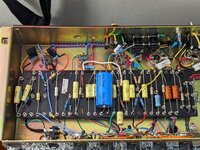sahlomonic
Well-known member
Starting to apply the BE100 circuit to my Ceriatone 2204. Using my other Friedman modded amps as a tone reference, I'm getting close. The gain isn't quite hot enough, so I ended up removing the 470k to ground from the 3rd gain stage grid voltage divider (still attached in pic). Bottom end is lacking quite a bit, even with the fixed 220k/ 4n7 depth. I could put it on a pot, but would rather see what I can get back from the preamp. 2n2 couplers per the schematic, but thinking about changing one of them back to 22n, or even 4n7?
Also, tips and advice on how to better route and dress the wiring mods I did are appreciated. (SAT switch is next on the list to re-wire)

Also, tips and advice on how to better route and dress the wiring mods I did are appreciated. (SAT switch is next on the list to re-wire)

